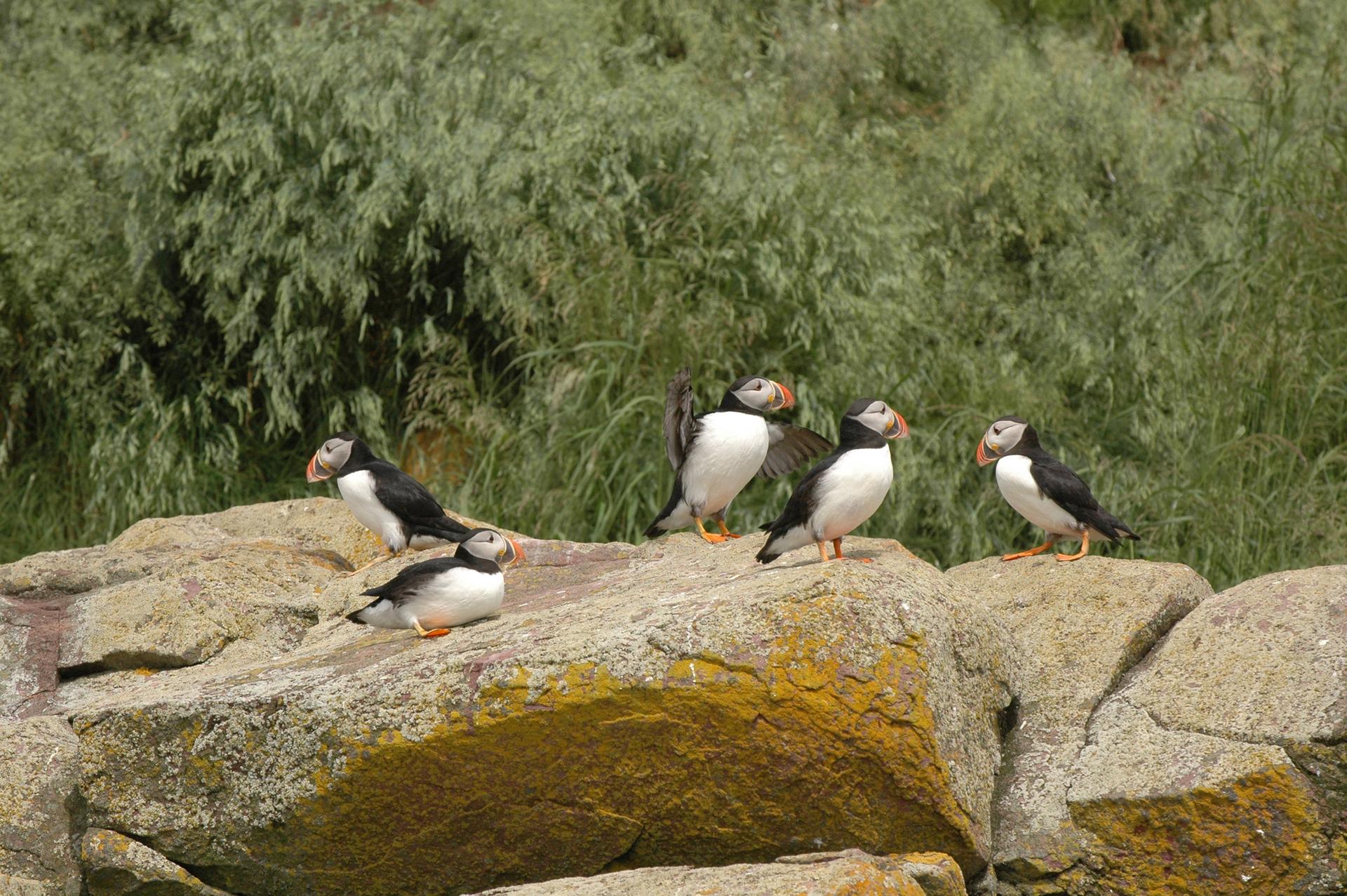Newfoundland and Labrador's incredible wildlife

Craggy, charming, and carved by the sea, Newfoundland and Labrador, Canada's farthest point east, is celebrated for its raw natural beauty and lost-in-time, fog-shrouded seaside fishing villages. Not surprisingly, the wildlife is similarly spectacular: Breaching humpback whales, giant polar bears, comical cliff-diving puffins, and herds of browsing caribou. Here are the top critters and where to see them in their element.
Atlantic puffins, Elliston
If you haven't seen them before, it's hard to believe puffins aren't cartoon characters. These cute, orange-footed, diminutive seabirds scurry across green-carpeted cliffs, then plunge head first over the edge diving some 200 feet down to the sea. Elliston is the place with the closest land views of these little clowns in North America. The puffin is the province's official bird and you can see why.
A sleepy hamlet on the windswept Bonavista Peninsula, Elliston, aka Bird Island Cove, overlooks the Atlantic. Some 2,500 Atlantic puffin pairs nest here May to September in the grassy cliffs, just a five-minute walk from the village, where you'll want to stay for a famed root cellar dinner. Another option is from a boat with Gatherall's Puffin and Whale Watch to Witless Bay Ecological Reserve, where you're likely to see blue-green icebergs floating by, too. Tours board just outside of St. John's.
Polar bears, Torngat Mountains
You can't get the experience of communing with wild animals in profound solitude and the immensity of the wilderness anywhere but the far-flung Torngat Mountains in Labrador, a place so remote that getting there is a big part of the adventure. From a scientists' research camp at Torngat Mountains Base Camp in the national park, a Labrador Inuit guide can take you out fishing for trophy-worthy Arctic char and boating through the deep fjords glacier-cut by 3,000-foot-high mountains in search of minke whales in the water and on shore black bears, moose, and caribou, even muskox and wolf, and the largest of all, polar bears.
Whales, Quirpon Island
You can spy whales (and icebergs) all over Newfoundland and Labrador, by sea kayak, boat, or land -- even right outside capital St. John's. That's because 22 species of whales and dolphins swim in the Atlantic Ocean just off the coast. This includes the world's largest population of humpbacks, and also minke (the smallest baleen whale), pilot, fin, sperm, blue, and orca, plus acrobatic dolphins and porpoises. Whale watching from Quirpon Island, though, is something special. This is a delightfully small island with a historic white-and-red 1922 lighthouse perched above "Iceberg Alley" on Newfoundland's northern tip. Stay at the Quirpon Lighthouse Inn where the giants, especially humpbacks and minke, surface literally a stone's throw from the shore. Watch from the cliffs or take a Zodiac tour.
Northern safari, Labrador
Far off the beaten path, Labrador gives new meaning to the term wild. This untamed, unspoiled wilderness, frozen for much of the year and with few roads, is teeming with creatures. Take a Northern safari cruise, with side trips out on the water in Zodiacs, to see them all: Polar bears, wolves, and caribou, plus fox, black bear, and in the water, Atlantic salmon and whales. You'll understand why Agvituk, Hopedale's Inuit name, means "place of whales." Wintertime dogsledding is another way to get into the backcountry and see animals in their natural habitat, with the likelihood of a spectacular aurora show. The pros at Northern Lights Dogsledding in Happy Valley-Goose Bay take guests out on exhilarating adventures.
Caribou and moose, Gros Morne
Summit dramatic Gros Morne Mountain for epic views of raw and dramatic Gros Morne National Park, a UNESCO World Heritage Site on the province's west coast. While you're at it, be on the lookout for woodland caribou at the second-largest park in Atlantic Canada after Torngat Mountains. You can see many of these large-antlered herbivores grazing on grass in herds of 20 to 40 from pull-offs right along the Viking Trail highway. Another hot spot is in the park's deserty and geologically significant Tablelands. Tackle the 2.5-mile Tablelands hike in search of caribou and also towering moose, which roam all over Gros Morne in huge numbers. Western Brook Pond, a picture-perfect fjord with impressive waterfalls and an inviting sandy beach, is a moose hot spot and ideal for touring by boat. Stop in at the Discovery Centre near Woody Point to learn more about the area and wildlife.
Seabirds galore, Cape St. Mary’s
With emerald cliffs towering above the sapphire-blue sea far below, Cape St. Mary's Ecological Reserve is the definition of spectacular. The birds think so, too. Thousands of seabirds convene on the cliffs, creating a cacophony of squawking and turning the gray rocks into a sea of white gulls and murres perching, landing, and diving. This is the most southerly breeding area in the entire world, in fact, for thick-billed murres. There are also razorbills, black-legged kittywakes, northern gannets, and various types of cormorants, plus eagles and osprey -- it's quite a sight. Cape St. Mary's is popular because it's the most accessible rookery around for bird watching. Walk right to the edge and peek over if you dare. A whopping 35 million seabirds call Newfoundland home, giving it the nickname "the seabird capital of North America," and this is the place to see them.
After some bucket list wildlife viewing, check out Newfoundland's other top to-dos while eating and drinking your way through Canada's most easterly province.
Plan your wildlife adventures at the Newfoundland and Labrador Tourism website.